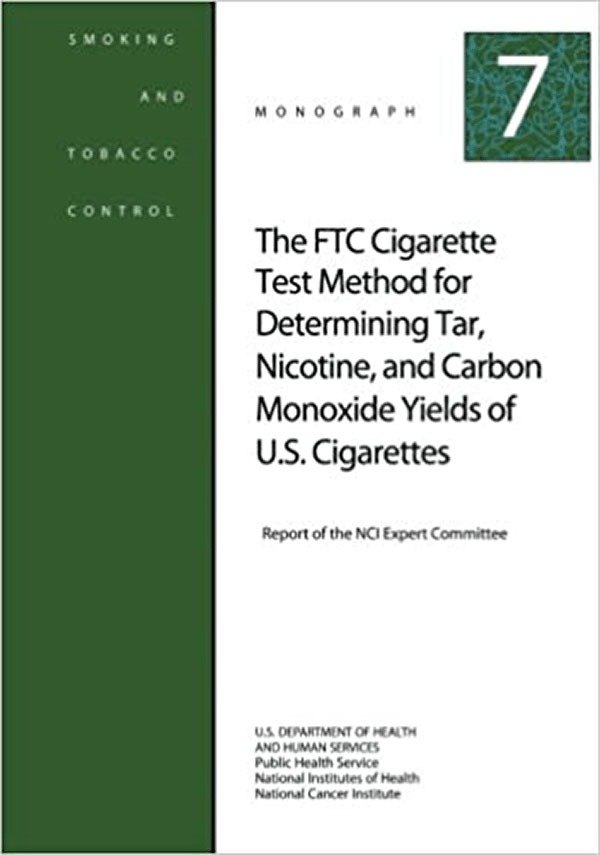
Reviews the Federal Trade Commission (FTC) protocol for determining tar, nicotine, and carbon monoxide yields of cigarettes and provides contextual research on smokers’ attitudes toward low-yield cigarettes, smokers’ tendency toward compensatory smoking behaviors, and consumer protections.
On This Page
Suggested Citation
National Cancer Institute. The FTC Cigarette Test Method for Determining Tar, Nicotine, and Carbon Monoxide Yields of U.S. Cigarettes. Report of the NCI Expert Committee. Tobacco Control Monograph No. 7. Bethesda, MD: U.S. Department of Health and Human Services, National Institutes of Health, National Cancer Institute. NIH Pub. No. 96-4028, August 1996.
View Individual Chapters
Chapters and key topics covered within each chapter are listed below. Chapters generally include an introductory section, details on methodology, a chapter summary, research needs, and a reference list.
- Foreword (PDF, 393 KB)
- Acknowledgments (PDF, 488 KB)
- Contents (PDF, 222 KB)
Section I
- Chapter 1. Cigarette Testing and the Federal Trade Commission: A Historical Overview (PDF, 596 KB)
- Question-and-Answer Session
- Chapter 2. Review of the Federal Trade Commission Method for Determining Cigarette Tar and Nicotine Yield (PDF, 427 KB)
- Question-and-Answer Session
- Chapter 3. Changes in Cigarette Design and Composition Over Time and How They Influence the Yields of Smoke Constituents (PDF, 1.3 MB)
- Background
- Changes in Cigarette Design and Composition
- Question-and-Answer Session
- Acknowledgments
- Chapter 4. Attitudes, Knowledge, and Beliefs About Low-Yield Cigarettes Among Adolescents and Adults (PDF, 1.6 MB)
- Monitoring National Data
- Survey Findings
- Health Beliefs and Switching
- Quitting Smoking
- Discussion
- Question-and-Answer Session
- Chapter 5. Cigarette Smoke Components and Disease: Cigarette Smoke Is More Thana Triad of Tar, Nicotine, and Carbon Monoxide (PDF, 1.2 MB)
- Mainstream Vs. Sidestream Cigarette Smoke
- Major Health Effects of Cigarette Smoke
- Cancer
- Noncancerous Lung Disease
- Atherosclerotic Cardiovascular Diseases
- Cigarette Smoking and Human Reproduction
- Absolute Risk Vs. Relative Risk
- Tar, Nicotine, Carbon Monoxide, and Other Smoke Constituents
- Smoke Constituents, Cigarette-Related Disease, and Modified Labeling of Cigarettes
- Question-and-Answer Session
- Acknowledgment
- Chapter 6. The Changing Cigarette and Disease Risk: Current Status of the Evidence (PDF, 1 MB)
- Epidemiologic Evidence on the Changing Cigarette and Disease Risks
- Conclusions
- Question-and-Answer Session
- Chapter 7. Biomarkers of Cigarette Smoking (PDF, 1 MB)
- Use of Various Biomarkers
- Nicotine Absorption From Cigarettes
- Nicotine Content of Tobacco Vs. FTC Yield
- Quantitating Nicotine Intake in Smokers
- Cotinine Levels and Nicotine Intake
- Ultralow-Yield Cigarettes
- Nicotine Intake and Machine-Determined Yield
- Carbon Monoxide and FTC Yield
- Tar-to-Nicotine Ration
- Conclusions
- Question-and-Answer Session
- Acknowledgment
- Chapter 8. Pharmacology and Markers: Nicotine Pharmacology and Addictive Effects (PDF, 1 MB)
- Cigarette Smoking as Drug Dependence
- Nicotine Delivery Systems
- Nicotine's Effects
- Smoking and Nicotine Dose
- A Proposal for More Meaningful Cigarette Labeling
- Question-and-Answer Session
- Chapter 9. Consumer/Smoker Perceptions of Federal Trade Commission Tar Ratings (PDF, 519 KB)
- Tar Level of Cigarettes
- Knowledge of Advertised Tar Numbers
- Smokers’ Interpretations of Tar Numbers
- Smokers’ Use of Advertised Tar Numbers
- Conclusions
- Question-and-Answer Session
- Chapter 10. Sensitivity of the Federal Trade Commission Test Method to Analytical Parameters (PDF, 822 KB)
- Standard Machine Smoking
- Influence of Smoking Parameters
- Influence of Human Smoking Practices
- Conclusions
- Question-and-Answer Session
- Acknowledgment
- Chapter 11. Human Smoking Patterns (PDF, 751 KB)
- How Do Humans Smoke?
- Which Human Smoking Behaviors Determine Smoke Exposure?
- Are Human Smoking Patterns Dynamic or Static?
- Does the FTC Mthod Accurately Reflect Human Smoking Patterns
- Summary
- Question-and-Answer Session
- Chapter 12. Compensation for Nicotine by Smokers of Lower Yield Cigarettes (PDF, 792 KB)
- Background
- Cigarette Brand Switching in Experimental Research
- Research
- One Repeated-Measures Study of Self-Selected Brand Switching
- Smokers Can Get High Yields From the Lowest of the Low-Yield Cigarettes: More on the Issue of Vent Blocking
- Graphic Information on Tar and Nicotine Yields: The Color-Matching Technique
- Summary
- Question-and-Answer Session
- Chapter 13. Cigarette Design Technologies Reduce Smoke Yield and Expand Consumer Choices: The Role and Utility ofthe FTC Test Method (PDF, 1.3 MB)
- Background
- Cigarette Design and Changes in the Cigarette Market
- Utility of the FTC Test Method
- Question-and-Answer Session
Section II
- Transcript of Second-DayDiscussion (PDF, 3 MB)
Section III
- Recommendations and Findings (PDF, 656 KB)
Section IV
- Overview of 1980 to 1994 Research Related to the Standard Federal Trade Commission Test Method for Cigarettes (PDF, 1.6MB)
- Paramets of the FTC Test Method and Current Smoking Patterns
- Impact of Changing Parameters of the FTC Test Method on Absolute Yields of a Cigarette Brand and Relative Yields on Different Brands
- Tar and Nicotine Yield by the FTC Test Method and Amounts Delivered to Smoker
- Relative Yields of Differents Brands by the FTC Test Method and Amount of Nicotine Absorbed by Smokers
- Yield by the FTC Test Method and Absorption of Nicotine in Switchers
- Yields by the FTC Test Method and Other Constituents Using the FTC Puff Profile
- Proposals To Change the FTC Test Method

